|
||||||||||||
TOPKAPI
PALACE It was built between 1466 and 1478, a couple of years before the death of Fatih. Unlike any European Palace, its architecture is predominantly Middle Eastern in character. The initial construction was Cinili Mansion, a Glass Palace finished in 1472, and the imposing main gate facing Sultanahmet, Bab-I Humayun, and the Palace ramparts, were completed in 1478. There were originally 750 residents of the Palace, during Fatih’s period, which became drastically more congested reaching 5000 during normal days and 10,000 during festivals. Extensions had to be built, and the harem was completed in 1595 during the third Sultan Murad’s era, after which the harem residents were moved in from the palace at Beyazit, with a total of 474 concubines. Special tours of the Harem are available. The Harem, literally meaning “forbidden” in Arabic, was the suite of apartments in the palace belonging to the wives, concubines and children of the head of the household. Around the Harem were the Circumcision Room, the apartments of the Chief Black Eunuch, and apartments of the sultan – in total over 400 rooms. Other highlights in the Palace are the Spoonmaker’s Diamond (the fourth largest diamond in the world), the Topkapi Dagger, (a gift from Mahmut I), a vast collection of paintings and miniatures, and the Pavilion of the Holy Mantle (including a footprint, a tooth and a hair of the Prophet Mohammed). Opening hours: Daily 09.00 – 17.00, winter closed Tuesday. Emperor Iustanianus (527 – 565) wanted to construct something even bigger than the original two and appointed architects Isidoros from Miletos, and Anthemios from Tralles to build the Aya Sophia which still stands. Columns, heads, marble and coloured stones were imported to Istanbul from ancient cities in Anatolia for the purpose. The construction began on 23 December 532, and was completed exactly five years later. The main, central section measured 100m x 70m, covered with a 55m high dome which was a mammoth 30m in diameter – appearing to be a great feat of design. The mosaics are of great importance, and the oldest ones are dominated by geometric and plant motifs decorated with gold. The worst desecration of the church was in 1204, ransacked by Catholic soldiers during the Fourth Crusade. In 1453, after a failure of the Byzantine Church to fend off the Turks, Mehmet the Conqueror captured the city, rode into Aya Sofia and immediately turned it into a mosque. It was repaired several times, and Islamic ornamentation added, for example an extract of the Koran by calligrapher Izzet Efendi inscribed on the dome. The other reminders of its previous status as a mosque include huge wooden plaques bearing the names of Allah, the Prophet Mohammed and the first four caliphs. The marble and mosaics remain the most interesting aspects today. The columns supporting the gallery are made from antique marble, and in the western gallery is the green marble which marks the position of the throne of the Empress. The impressive figurative mosaics include Virgin and Child flanked by two emperors, dating back to the late 10th century, and one depicting Christ, the Virgin, and St John the Baptists. Even though there is partial damage, the haunting images on their faces remain as strong as ever. Opening hours: 09.30 - 16.30, daily except Monday. It fell into disuse and was then restored in 1987 with the mud and water removed, and narrow raised pathways providing easy access for visitors. It is the largest covered cistern in the city, measuring 140 by 70 metres. Opening hours: 09.00 - 17.00 closed Tuesdays. Traditionally the more valuable goods were in the old central area, called Ic Bedesten, because it was more secure. As quite typical of the area, most streets are laid out and devoted to a particular trade, for example gold on Kuyumcular Caddesi, leather on Bodrum Han, and shoes on Kavaflar Sokak. But the trade has also spilled out onto the surrounding streets, and it is very common to see Russian traders buying up huge sacks of leather jackets or shoes outside the main entrance. Even the streets leading to the Golden Horn are lined with outdoor stalls, which have traditionally been controlled by strict trading laws to reduce competition between traders. Apart from the usual shops selling clothes, textiles, jewellry and carpets,
there are small workshops where craftsmen cast and beat silver or brass,
in a skilled trade handed down through the generations. If all that shopping,
bargaining and fending off persuasive salesmen is a little too tiring,
there are also traditional cafes dotted inside the bazaar in which to
relax, eat and sip tea. There are also money-changing booths inside and
out. It is slightly less crowded during weekdays, as most locals shop
at weekends. Today, the square forms the centre of Istanbul’s historical, cultural and tourist life, and the surrounding wooden houses – especially the 18th century ones on Sogukcesme Sokak – were recently restored giving them a new lease of life as small hotels. |
||||||||||||
|
||||||||||||

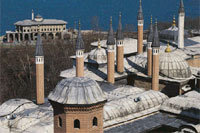
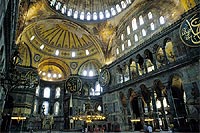 Aya Sophia was, for nearly a thousand years, the largest enclosed space
in the world, and still seen as one of the world’s most important
architectural monuments. It is one of Turkey’s most popular attractions,
drawn by the sheer spectacle of its size, architecture, mosaics and art.
Aya Sophia was, for nearly a thousand years, the largest enclosed space
in the world, and still seen as one of the world’s most important
architectural monuments. It is one of Turkey’s most popular attractions,
drawn by the sheer spectacle of its size, architecture, mosaics and art.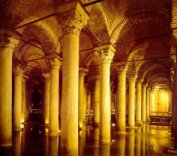 Nearby Aya Sofia is the 6th century Byzantine underground Basilica cistern,
with 335 massive Corinthian columns supporting the immense chamber’s
fine brick vaulting. This is one of several buried into the city’s
foundations, and the first to have been excavated and renovated. Thought
to have been built in the 4th century by the emperor Constantine, then
enlarged two centuries later, it was supplied with water from Belgrade
Forest, amd supplied it to the Great Palace and Topkapi Palace.
Nearby Aya Sofia is the 6th century Byzantine underground Basilica cistern,
with 335 massive Corinthian columns supporting the immense chamber’s
fine brick vaulting. This is one of several buried into the city’s
foundations, and the first to have been excavated and renovated. Thought
to have been built in the 4th century by the emperor Constantine, then
enlarged two centuries later, it was supplied with water from Belgrade
Forest, amd supplied it to the Great Palace and Topkapi Palace.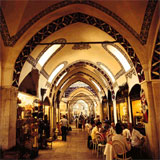 The oldest and biggest closed bazaar in the world, also known as the Grand
Bazaar, has around 4000 shops and over 60 alleyway, covering a huge labyrinth
in the city centre. The original two structures, covered with a series
of domes and remains of the 15th century walls, became a shopping area
by covering the surrounding streets and adding to it over the following
centuries. In Ottoman times this was the centre of trading, and a vital
area of town. The Sandal Bedesten was added during Suleyman’s reign,
to cope with the rising trade in fabrics, during the 16th century.
The oldest and biggest closed bazaar in the world, also known as the Grand
Bazaar, has around 4000 shops and over 60 alleyway, covering a huge labyrinth
in the city centre. The original two structures, covered with a series
of domes and remains of the 15th century walls, became a shopping area
by covering the surrounding streets and adding to it over the following
centuries. In Ottoman times this was the centre of trading, and a vital
area of town. The Sandal Bedesten was added during Suleyman’s reign,
to cope with the rising trade in fabrics, during the 16th century.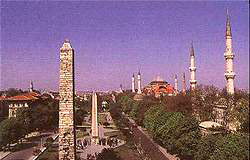 The ancient Hippodrome, scene of chariot races and the centre of Byzantine
civic life, stands in the area that is now in front of the Blue Mosque,
and now part of Sultanahmet. Of the ornaments which once decorated it,
only three remain: The Obelisk of Theodosius, the bronze Serpentine Column,
and the Column of Constantine. Remains of the curved end of the Hippodrome
wall can be seen on the southwest side of the three.
The ancient Hippodrome, scene of chariot races and the centre of Byzantine
civic life, stands in the area that is now in front of the Blue Mosque,
and now part of Sultanahmet. Of the ornaments which once decorated it,
only three remain: The Obelisk of Theodosius, the bronze Serpentine Column,
and the Column of Constantine. Remains of the curved end of the Hippodrome
wall can be seen on the southwest side of the three. SULTANAHMET FOUNTAIN
SULTANAHMET FOUNTAIN 


